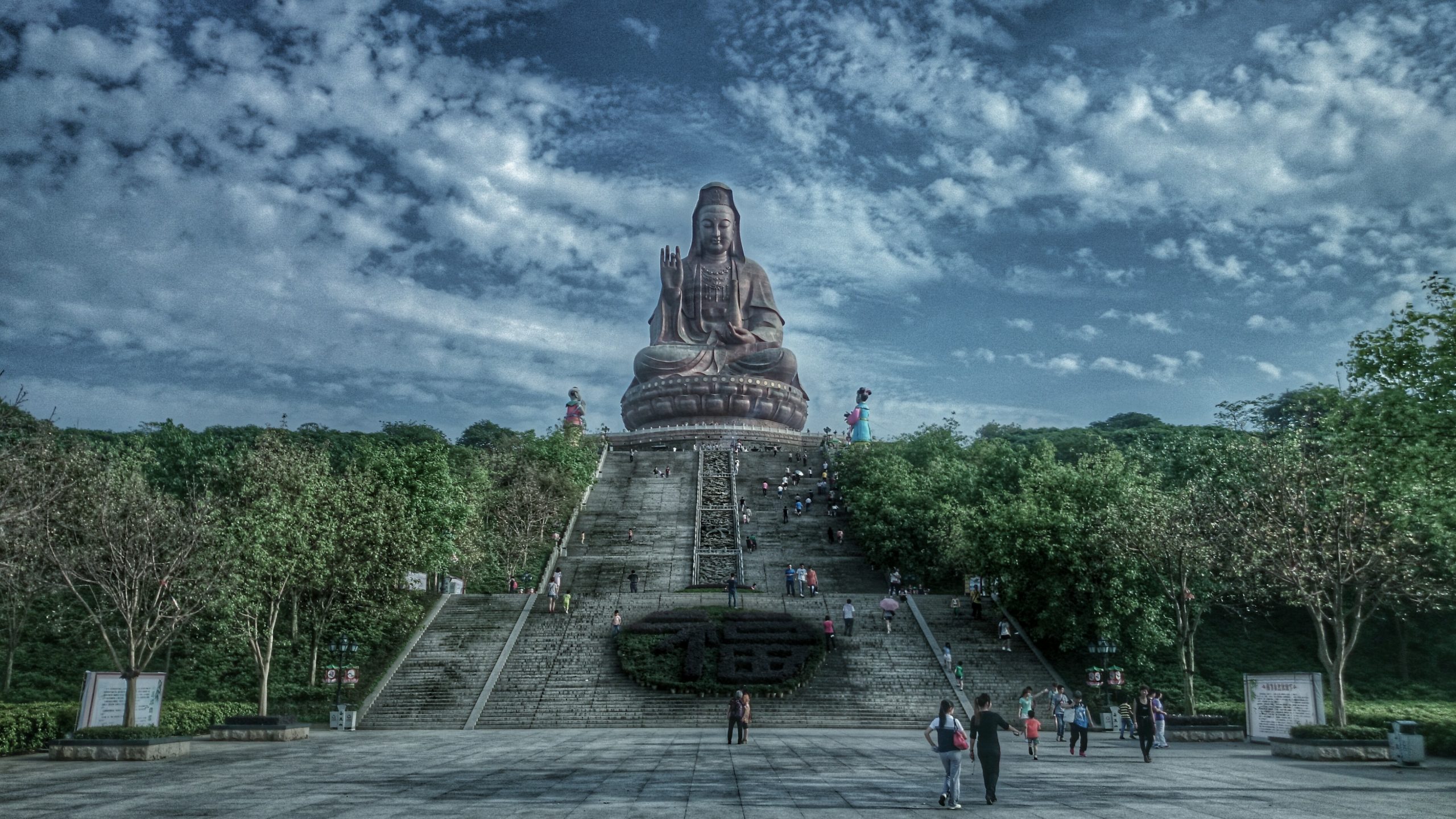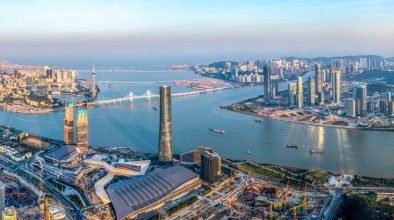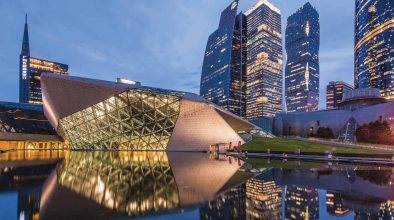TEXT Luo Xunzhi
In the competition among cities in the GBA, Foshan has a few trump cards to play. It has an excellent transport system, with an intercity line to Guangzhou and high-speed lines to Jiangmen, Zhuhai, Shenzhen, and Hong Kong.
The manufacturing powerhouse of Foshan has a key role to play in the development of the Greater Bay Area (GBA) as it moves to upgrade from traditional to state-of-the-art industries.
The GBA is one of China’s national economic strategies for the next 20 years, developing a world-class megalopolis out of two SARs (Macao and Hong Kong) and nine cities of Guangdong province (Guangzhou, Shenzhen, Dongguan, Foshan, Jiangmen, Zhaoqing, Zhongshan, and Zhuhai).
According to estimates by China Centre for International Economic Exchanges, by 2020, the total economic output of the GBA will be comparable to that of the Greater Tokyo Area. By 2030, its GDP will reach US$4.62 trillion, exceeding that of Tokyo, Greater New York and the San Francisco Bay Area, to become the world’s largest such megalopolis in terms of economic output.
The nine cities, home to just 52 per cent of Guangdong’s population, account for 85 per cent of the province’s economic output. Foshan ranks fourth in terms of GDP, behind Hong Kong, Shenzhen, and Guangzhou. In 2017, Foshan’s GDP reached RMB954.96 billion (US$139.02 billion), up 8.5 per cent in 2016, according to the city’s statistical bureau.
The 11 cities of the GBA are divided into three levels, according to their economic size, with Hong Kong, Shenzhen, and Guangzhou in level one. Around each of these is a city cluster: Hong Kong, Macao, Zhuhai, and Jiangmen form one cluster while Shenzhen, Huizhou, Dongguan, and Zhongshan form the second. The third is Guangzhou, Zhaoqing and Foshan, which is considered a level-two city along with Dongguan.
Foshan’s great strength is in manufacturing, which generates nearly 60 per cent of its GDP, the highest among the 11 cities, compared to 40 per cent for Shenzhen, and 30 per cent for Guangzhou. While currently much weaker in terms of cargo handling, outranking only Huizhou and Zhaoqing, its numbers are improving. In 2017, its port handled 79.67 million tons of goods, up 20.5 per cent; of these, there were 3.9 million containers, up 21.3 per cent.


Leveraging assets
In the competition among cities in the GBA, Foshan has a few trump cards to play. It has an excellent transport system, with an intercity line to Guangzhou and high‐speed lines to Jiangmen, Zhuhai, Shenzhen, and Hong Kong. With direct connections to all three city clusters, Foshan is within one‐hour travel distance of all of the cities in the GBA.
In January, Foshan Mayor Zhu Wei announced that the city would start construction of a new airport in the Gaoming district this year. Aiming to become an aviation hub in the western GBA, the city is also planning an aviation economic zone around the airport. Construction is slated for completion in 2021 (the city currently relies on Guangzhou’s Baiyun International Airport).
Foshan has a powerful private sector, whose industrial output in 2017 rose 10.2 per cent from a year earlier and accounted for 81.3 per cent of the city’s overall industrial growth. It has nationwide brand companies like Jianlibao, New Zhongyuan Ceramics, Midea, and Foshan Haitian Flavouring & Food.
The city has long been a magnet for foreign investment, which totalled US$80.89 billion at the end of February 2018. Among them are 60 Fortune 500 companies which have invested in 116 projects, including food, auto parts, electrical equipment, and chemicals. Notable firms include Anheuser‐Busch, Walmart, Kohler, Toshiba, Toyota, Siemens, Fiat, ArcelorMittal, and Shell.
Foshan companies themselves are starting to invest heavily abroad. Between 2015 and 2017, they launched 112 overseas investment projects, involving US$5.8 billion.
By 2017, 54 Foshan firms had gone public, with a combined market capitalisation of RMB972.2 billion (US$140.8 billion). Gains in this important economic platform were strong enough to land Foshan in the top 10 cities in China in terms of the market capitalisation of its listed companies for the first time, ranking seventh in the country.
The city has long been a magnet for foreign investment, which totalled US$80.89 billion at the end of February 2018. Among them are 60 Fortune 500 companies which have invested in 116 projects.
The city government is designing its industrial strategy to meet the objectives of the national Made in China 2025 plan. This involves improving the quality and efficiency of its six traditional industries while simultaneously introducing new innovative and high‐technology products.
Foshan leads the country in production and sales of ‘white goods,’ large‐scale appliances including microwave ovens, washing machines, and refrigerators. In 2017, the household appliance industry had a total output value of RMB211.17 billion (US$30.74 billion), up by 9.1 per cent over 2016. The sector accounted for 24.7 per cent of the output of the six traditional industries (automobiles and auto parts, ceramics, furniture, textiles, metal products, and household appliances).
In the last few years, the city has worked hard to integrate its manufacturing industry with internet, big data and AI technologies, to accelerate the expansion of the digital economy.
The Midea Group, a Fortune 500 company, is working with German robotics company KUKA to upgrade its manufacturing processes. The company, based in Augsburg, Germany, is a global leader in industrial robots and factory automation. After making an initial offer in 2016, Midea took over the firm in January 2017 by buying 74.55 per cent of its share, increasing their total stake to 94.55 per cent. In 2017, KUKA recorded annual revenue of EUR3.5 billion and employed more than 14,200 workers.
Foshan is home to four automobile makers: the South China base of FAW‐Volkswagen, Beiqi Foton Motor and two manufacturers of special‐ ‐purpose vehicles. In addition, the city government has set up a production base for new energy vehicles (NEVs), which includes R&D centres, production of essential parts, and recycling and reusing of batteries. More than 20 leading companies have already moved into the ‘NEV Town’ in the city’s Shunde district. It aims to develop the Internet of Vehicles, cloud computing, and other big data technologies.
As part of Healthy China 2030, Foshan has prioritised development of biomedicine, medical devices and health services, as well as modern Chinese medicine and food and beverages. It aims to foster a highly concentrated cluster of this sector, considered the most promising in the 21st century.
This past April, at a conference on technology innovation in the city, Mayor Zhu said that innovation in such industries was essential to support its economic and social development.
In February, the city announced that it would build the Foshan Advanced Manufacturing Science and Technology Guangdong Laboratory over five years with a total investment of RMB5.5 billion (US$793.65 million), raised from the city and district governments.
Known more succinctly as Jihua Lab, it will cover an area of about 67 hectares and be located next to Wenhan Lake in the Nanhai district, an area considered the core region of the city’s high-end innovation cluster. By the construction midpoint in 2020, there should be nine laboratories, including robot and advanced control and biomanufacturing.
In June 2018, the city hosted the GoforIsrael conference for the first time, attracting 1,200 participants and more than 500 Chinese investors. One hundred entrepreneurs from Israeli startups and high‐tech companies in areas including AI, IT, cyber, energy, life sciences, telecom and automotive technologies used the event to introduce their technologies to Chinese investors.
Nadav Cohen, Israeli consul-general in Guangzhou, noted the central role of Foshan in developing the GBA into the largest technology centre in the world, as well as its key role in the Belt and Road Initiative.

Diverse industrial base
Data from the city’s Statistical Bureau showed GDP in 2017 reached RMB954.96 billion (US$51.68 billion), an increase of 8.5 per cent from 2016. Of this, manufacturing accounted for the largest share, RMB557 billion (US$80.37 billion), up 8.2 per cent. The service sector was next with RMB383 billion (US$55.26 billion), up 9.1 per cent, and agriculture and forestry third with RMB14.6 billion (US$2.10 billion), up 1.9 per cent.
The private sector is the main driver of growth in the city. In 2017, its GDP was RMB606.7 billion (US$87.54 billion). Gross domestic product generated by firms with investment from Hong Kong, Macao, Taiwan, and abroad rose by 8 per cent.
Among the fastest growing industrial sectors were calculators and office machinery, up 17.6 per cent; electronics and telecommunications equipment, up 16.6 per cent; medical equipment and metres, up 11.1 per cent; and pharmaceuticals, up 8.3 per cent. Output of petrochemicals grew by 9.5 per cent, new materials 1.9 per cent, and bio‐technological products and high‐end medical machinery, 2.1 per cent.
During the year, the city received 49.3 million visitors, up 7.9 per cent. There were 275,400 foreigners, up 7.9 per cent, and 1.186 million from Hong Kong, Macao and Taiwan, up 3.8 per cent.
The city’s traditional industries remained strong with most seeing double‐digit growth: metallic items (17.1 per cent); furniture (11 per cent); construction materials (10.9 per cent); food and beverages (10.6 per cent); domestic electrical appliances (9.1 per cent); and textiles and garments (7.3 per cent).
Foshan continues to be one of China’s biggest manufacturers of domestic appliances. In 2017, local manufacturers produced 6.65 million gas stoves, up 1.5 per cent; 8.45 million gas water heaters, up 2.8 per cent; 15.92 million room air conditioners, up 3.3 per cent; 26.7 million pieces of furniture, up 11 per cent; and 4.65 million washing machines, up 33.7 per cent. Microwave ovens saw a significant decrease, down 30.8 per cent to 37.6 million.
In 2017, investment in real estate hit RMB145.4 billion (US$20.98 billion), up 18.2 per cent, of which RMB101.7 billion (US$14.67 billion) went into residential properties, up 17.9 per cent.
During the year, the city received 49.3 million visitors, up 7.9 per cent; of these, 14.98 million stayed at least one year, up 10.9 per cent. There were 275,400 foreigners, up 7.9 per cent, and 1.186 million from Hong Kong, Macao and Taiwan, up 3.8 per cent. Tourism brought in RMB70.97 billion (US$10.24 billion) for the city, up 13.6 per cent.
In 2017, Foshan exported RMB315.4 billion (US$45.51 billion) worth of goods, up 1.7 per cent, and imported RMB120.4 billion (US$17.37 billion), up 19.6 per cent. Exports to Hong Kong dropped 6.1 per cent to RMB41 billion (US$5.92 billion), while those to the US went up 10.9 per cent to RMB49.5 billion (US$7.14 billion). Actual foreign direct investment during the year totalled US$1.623 billion, up 10.3 per cent. Of this, manufacturing accounted for 24.3 per cent, real estate 8.8 per cent, and retail and wholesale 2.6 per cent.
At the end of the year, the city had a population of 7.66 million, an increase of 2.6 per cent over end‐2016. The average income of urban residents was RMB46,849 (US$6,760), an inflation‐adjusted increase of 6.6 per cent, while rural residents averaged RMB26,390 (US$3,808), an inflation‐adjusted increase of 7.2 per cent.

Foshan, a city to visit
Foshan is a city rich in history: birthplace of Cantonese opera, the lion dance and several schools of martial arts, it also boasts numerous examples of Lingnan traditional architecture and folk culture.
- The city takes its name, which translates as ‘Buddha Mountain,’ from a hill near the centre of town where three bronze sculptures of the Buddha were discovered in 628 AD. A monastery was founded nearby, with Foshan growing up around it. When the monastery was de‐ stroyed in 1391, a Taoist temple became the new focus of the community.
- By the early Ming dynasty (1368– 1644), Foshan had developed into one of the four great markets of China, thanks to its booming ceramics and metal industries. It emerged as a major steel producer in the 19th century, consuming most of the province’s iron ore production. Ceramics and steel remained the principal industries until the 1950s.
- Foshan is the birthplace of the Wing Chun school of martial arts. Some of its most famous practitioners, Leung Jan and his student Ip Man, also hail from the city. Ip, whose story inspired a series of successful films, in turn taught one of international cinema’s most prominent martial artists: Bruce Lee.

Martial arts enthusiasts and curious tourists alike flock to the city’s museum to Ip Man every year.







